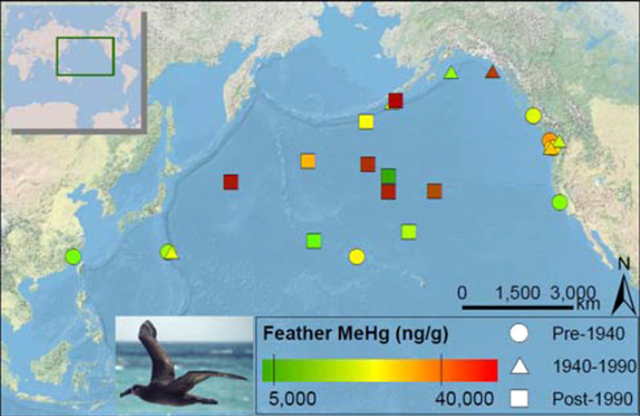Mercury on the rise in endangered Pacific seabirds
Contact: Todd Datz, 617.432.8413, tdatz@hsph.harvard.edu
18 April 2011 Boston, MA – Using 120 years of feathers from natural history museums in the United States, Harvard University researchers have been able to track increases in the neurotoxin methylmercury in the black-footed albatross (Phoebastria nigripes), an endangered seabird that forages extensively throughout the Pacific. The study shows that the observed increase in methylmercury levels, most likely from human-generated emissions, can be observed and tracked over broad time periods in organisms that live in the Pacific Ocean. The study was published in an online early edition on April 18, 2011, in the Proceedings of the National Academy of Sciences. The study has important implications for both environmental and public health, say the authors. “The Pacific in particular warrants high conservation concern as more threatened seabird species inhabit this region than any other ocean,” said lead author Anh-Thu Vo, who did her research while an undergraduate at Harvard and is currently a graduate student at the University of California, Berkeley. “Given both the high levels of methylmercury that we measured in our most recent samples and regional levels of emissions, mercury bioaccumulation and toxicity may undermine reproductive effort in this species and other long-lived, endangered seabirds.” The researchers collected feathers from black-footed albatross specimens in the Harvard University Museum of Comparative Zoology and the University of Washington Burke Museum of Natural History and Culture and analyzed methylmercury in samples from 1880 to 2002. They found increasing levels of methylmercury that were generally consistent with historical global and recent regional increases in anthropogenic mercury emissions. “Methylmercury has no benefit to animal life and we are starting to find high levels in endangered and sensitive species across marine, freshwater, and terrestrial ecosystems, indicating that mercury pollution and its subsequent chemical reactions in the environment may be important factors in species population declines,” said study co-author Michael Bank, a research associate in the Department of Environmental Health at Harvard School of Public Health (HSPH). “Using these historic bird feathers, in a way, represents the memory of the ocean, and our findings serve as a window to the historic and current conditions of the Pacific, a critical fishery for human populations,” said Bank. Consumption of mercury-tainted fish from the Pacific Ocean is an important source of human exposure to methylmercury in the United States and may lead to adverse neurodevelopment effects in children, he added. “Much of the mercury pollution issue is really about how much society values wild animal populations, yet we are also faced with the tremendous public health challenge of communicating potential risks from mercury exposure to vulnerable adult and child human populations. Although most people have low or no risk from mercury exposure, for the people who are at risk, for example, from excessive fish consumption, the problem can be considerable,” said Bank. Study co-authors include James Shine, HSPH Department of Environmental Health, and Scott Edwards, Museum of Comparative Zoology, Harvard University. Support for the study was provided by the Harvard University Museum of Comparative Zoology and the Harvard College Research Program. “Temporal increase in organic mercury in an endangered pelagic seabird assessed via century-old museum specimens,” Anh-Thu Vo, Michael S. Bank, James P. Shine, Scott V. Edwards, Proceedings of the National Academy of Sciences, online April 18, 2011.
Mercury on the Rise in Endangered Pacific Seabirds via Apocadocs
